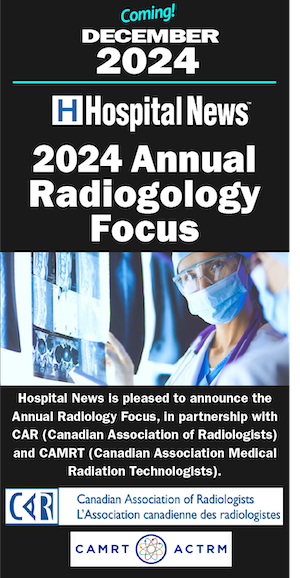While we all experience pain, it is estimated that about 340,000 Canadians suffer from chronic #neuropathic pain. The International Association for the Study of Pain describes neuropathic pain as “pain caused by a lesion or disease of the somatosensory nervous system”, which includes muscles, bones, joints, and other sensory systems. Patients often describe neuropathic pain as burning, stabbing, shooting, aching, or like an electric shock.
Currently there is no proven cure for neuropathic pain but one technology that is not well-known, and is, as a result, an underutilized treatment option, is #spinal cord stimulation (SCS).
SCS neurostimulators are about the size of a pacemaker (approximately 4 cm in diameter), and are typically placed under the skin of the abdomen. Like a pacemaker, the device used for SCS consists of two parts: an implantable medical device called a neurostimulator and thin, flexible wires called leads. Instead of delivering electrical impulses to the heart, however, the neurostimulator delivers them through the leads to the epidural space in the spinal cord. Normally, pain signals travel through the nervous system in the spinal cord, but the electrical pulses sent from the neurostimulator modify these pain signals before they reach the brain.
MORE: THE ASSSISTED DYING DEBATE
Neurostimulation, including SCS, was first developed in the 1970s by #Medtronic and now over 260,000 people worldwide have benefitted from SCS. In Canada, SCS therapy is indicated for the management of chronic, intractable pain of the trunk and/or limbs.
Despite its long history, many people are unclear about the evidence supporting the effectiveness of SCS compared to other forms of treatment for chronic neuropathic pain. A recent article by Toronto Western Hospital neurosurgeon Mohammed F. Shamji in The Journal of Current Clinical Care sheds some light on the effectiveness and indications for SCS, including leg-dominant failed back surgery syndrome, chronic inoperable limb ischemia, and painful diabetic neuropathy.
Leg-dominant failed back surgery syndrome represents persistent neuropathic leg pain following structurally corrective spinal surgery. Shamji notes that a large multi-centre randomized controlled trial for patients with failed back surgery syndrome found that 58 per cent of study subjects receiving SCS exhibited substantial pain relief versus only 17 per cent relief for those receiving conventional medical management. Another large trial had similar findings (47 per cent of patients receiving SCS saw substantial pain relief versus only 11 per cent for study subjects receiving conventional medical management).
Chronic inoperable limb ischemia is limb pain that occurs at rest, caused by a severe compromise of blood flow to the affected extremity. Shamji highlights a meta-analysis of six studies and nearly 450 subjects found pain relief were more frequently observed in the SCS group than in the medically treated group.
MORE: SURGICAL TECHNIQUES ON THE HORIZON
Painful diabetic neuropathy (PDPN) is a common complication of diabetes. SCS use in patients with PDPN was explored in a multi-centre randomized clinical trial in which both pain and quality of life were substantially improved in the SCS group compared with medical management and at six months 23 per cent of SCS participants were free of all analgesic use.
What does this mean for physicians?
Shamji concludes that while the management of neuropathic pain can be challenging, “it is incumbent on physicians managing chronic pain to be familiar with the array of potential interventions.” Moreover, he notes that as technology advances, the use of SCS will only grow.
Is spinal cord stimulation being effectively used to treat pain in Canada?
The Ontario Health Technology Advisory Committee (OHTAC) makes recommendations about health interventions to the health care system and the Ontario Ministry of Health and Long-Term Care. Its primary goal is to ensure that Ontario residents have access to health interventions that optimize patient outcomes and provide the best value for money.
In 2005, OHTAC estimated the need for SCS was 330-660 patient cases per year in Ontario. Last year, almost 10 years later, the most optimistic estimate is that only 15 percent of eligible patients in Ontario had access to SCS therapy. The national average is 23 percent, with access being the highest in Saskatchewan.
MORE: MOUNT SINAI’S JOURNEY TO MAGNET STATUS
The good news is that several Ontario hospitals are working to improve access to this technology, ensuring sustainable funding and comprehensive care.
How will I know if spinal cord stimulation will work for my patient or me?
Whether you are interested in SCS for yourself or for a patient, it’s important to discuss and determine the kinds of pain treatments that may work. The choice of treatment depends on the type of pain, its severity, and your/your patient’s response to pain treatment. If a pain specialist thinks you or your patient is a good candidate for spinal cord stimulation, you can discuss completing a screening test to see if it will provide adequate pain relief.




